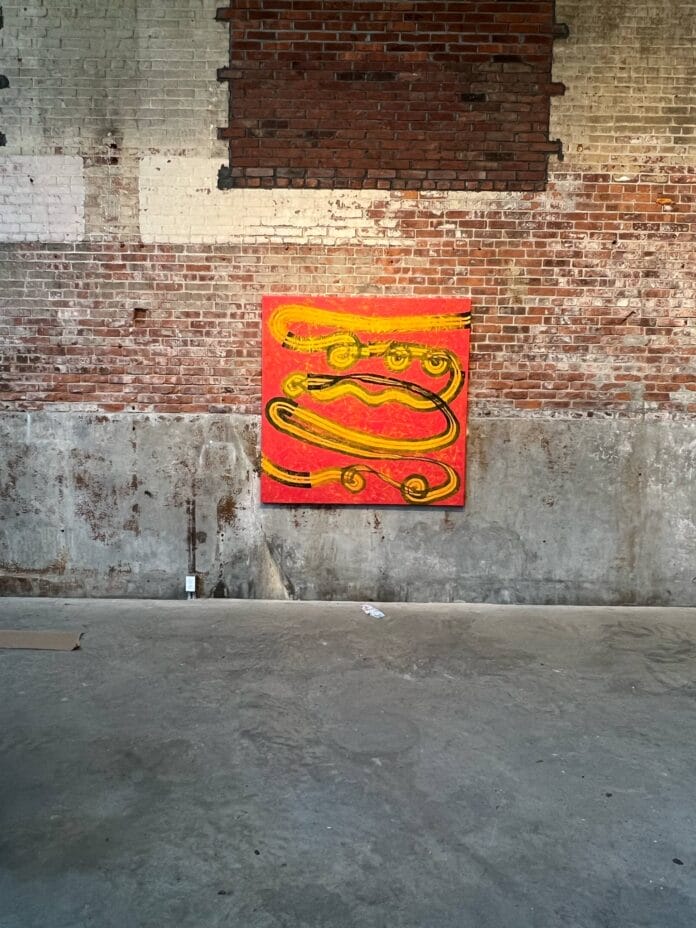New York-based artist Gordon Fearey creates abstract paintings that act as contemplative thresholds, inviting viewers into a space where the finite and the infinite collide. His latest body of work, the Lucretius Series, draws inspiration from the Roman poet and philosopher Lucretius, who described a universe with no center or edge—only an endless unfolding of matter and time.
Rooted in philosophical inquiry and a minimalist visual language, Fearey’s work explores what it means to exist within limits, while always surrounded by something unknowably vast. At the core of this series is a single, unbroken line that begins and ends at the edge of each canvas. This line represents the finite human experience—linear, temporal, and bounded—while the surrounding ground becomes a metaphor for infinity, the endless time and space in which life takes place.
Abstraction as Inquiry
Fearey’s practice has always been guided by abstraction, but not in a purely formalist sense. For him, painting is a form of philosophical questioning—a way to access what he calls the landscape beyond the window frame. This imagined space is not directly visible, but always sensed, hinting at something larger than the human eye can grasp.
He first became captivated by the idea of a painting as a window and the suggestion that something lies beyond its frame. If the painted scene was only a cropped view of something larger, then how far did the image extend? And what was the nature of the world it pointed to? These questions remain central to Fearey’s work—not because he seeks definitive answers, but because he remains compelled by the impossibility of fully understanding the infinite.
The Line as a Lived Gesture
In the Lucretius Series, Fearey sets himself a clear constraint: one continuous line that connects two opposing edges of the canvas. The simplicity of this gesture belies its conceptual and emotional weight. The line becomes a figure—a stand-in for human life, with a clear beginning and end—surrounded by a seemingly endless, indifferent ground.
The challenge, Fearey explains, is integrating the figure with the ground. This act becomes a metaphor for the human condition: trying to find coherence and connection within an infinite cosmos. The space around the line is not merely background; it is an active presence. As the ground defines and holds the figure, the painting becomes a quiet arena where time, space, and mortality are held in delicate balance.
The Power of Stillness
Fearey’s paintings do not shout. Instead, they offer a quiet that lingers, a visual and emotional stillness that opens space for contemplation. The restraint in color, form, and gesture is deliberate. Every brushstroke is purposeful, yet limited by time and human energy.
In embracing this limitation, Fearey connects with the very subject of his inquiry: the fleeting, finite nature of existence. His own mortality is echoed in each mark, each gesture that cannot go on forever. This confrontation with finitude is not mournful, but meditative. Through silence, Fearey’s work makes room for a different kind of seeing—one that listens.
Influences Beyond the Canvas
While painting is his primary medium, Fearey draws creative sustenance from writing and music. He is particularly inspired by how both art forms unfold in time, through sequences of moments and structured arcs. This sensibility is reflected in the temporal quality of his paintings, where each composition feels like a moment pulled from an unseen continuum.
His philosophical reading also shapes his thinking. The writings of Lucretius, with their rejection of cosmic centrality and emphasis on impermanence, resonate deeply. Fearey finds in these ideas a framework for exploring human experience—not as fixed or central, but as momentary and embedded within something far greater.
A Life in Art and Inquiry
Fearey’s work has been exhibited widely in New York and beyond. His paintings have been shown at The Drawing Center, New York Artists Equity, Lichtundfire Gallery, The Painting Center, SFA Projects, and ArtHelix, among others. Outside New York, he has exhibited at ECOCA in New Haven, Labspace in Hillsdale, Maryland Institute College of Art in Baltimore, and Brickbottom Gallery in Boston.
These exhibitions reflect a growing recognition of Fearey’s quietly radical practice—an art that refuses spectacle in favor of depth, and that places metaphysical inquiry at the center of the creative act.
Conclusion: A Space to Linger
The Lucretius Series exemplifies Gordon Fearey’s commitment to using painting as a tool for reflection. By staging a conversation between line and space, figure and ground, the finite and the infinite, he invites viewers into a place of stillness and depth.
His work does not aim to resolve philosophical questions, but rather to hold them gently. In the space between what is seen and what is felt, between a single line and the vastness that surrounds it, Fearey creates a space to linger—a place where presence and absence, time and eternity, exist in quiet harmony.


